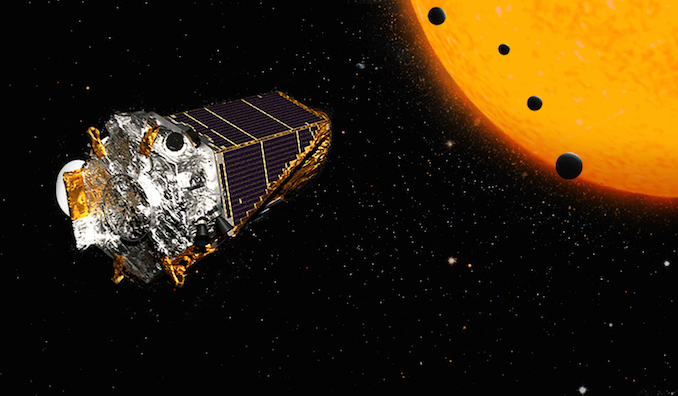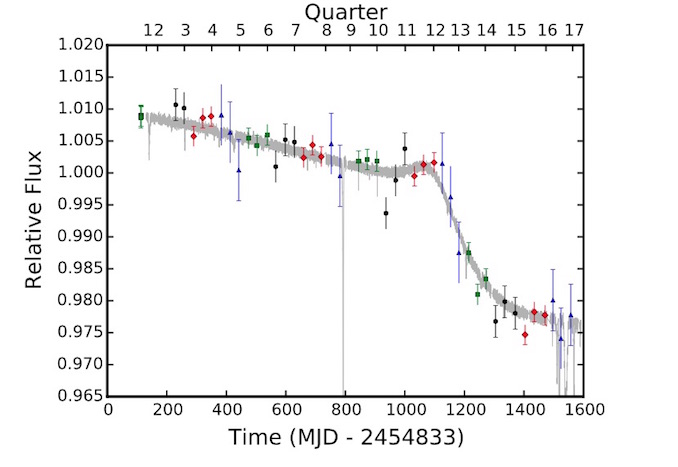
The so-called ‘most mysterious star in the galaxy’, also known as KIC 8462852, Tabby’s Star, the WTF (‘where’s the flux’) star and the ‘alien megastructure star’ thanks to the bizarre swarms of unknown objects transiting it, has become even stranger according to new analysis of old observations from the Kepler Space Telescope. Astronomers Ben Montet of the California Institute for Technology and Josh Simon of the Carnegie Institution looked back over the first four years of Kepler’s mission, during which it stared constantly at KIC 8462852 as well as 150,000 other stars while looking for exoplanet transits, to find that the mysterious star dimmed during that time at an unprecedented rate of 0.341 percent each year. Suffice to say, astronomers are at a loss to explain this dimming.
When KIC 8462852 hit the headlines in 2015, it sparked all manner of speculation as to the origin of its bizarre behaviour (see our earlier story). Citizen scientists, using the planethunters.com website to search for transits among the stars that Kepler has been watching, began noticing strangely irregular transits of KIC 8462852. When planets transit their stars they do so in predictable fashion, with periodic transits all of the same duration and magnitude. Instead, KIC 8462852 experiences hundreds of dips in light, all with different magnitudes and with no apparent periodicity. Whatever is causing KIC 8462852’s transits, it is clearly not planets. Aside from the irregularity of the transits, there’s just far too much material. A Jupiter-sized world would block one percent of the star’s light, but during these transits up to 22 percent of KIC 8462852’s light was being blocked. The implication is that there must be a heck of a lot of material surrounding the star.
Initially astronomers led by Tabetha Boyajian, previously of Yale University and now at Louisiana State University, attempted to make sense of it all by suggesting that the best explanation was a swarm of giant comet fragments resulting from a much larger body that had broken up around the star. Meanwhile, Jason Wright of Penn State University took a SETI angle, speculatively suggesting that the transits looked similar to what might be expected from orbiting ‘megastructures’, such as a partially-built Dyson swarm. A Dyson swarm, should one exist, would be composed of a multitude of solar collectors, absorbing the star’s radiated energy to provide the civilisation that constructed it with huge amounts of power.
However, earlier this year Louisiana State University astronomer Bradley Schaefer revealed that KIC 8462852 had been slowly dimming for at least a century at a rate of 0.165 magnitudes per century – notably lower than the rate of dimming derived by Kepler. He came to this conclusion after studying historical photographic plates of the star that had been digitised as part of the Digital Access to a Sky Century at Harvard, or DASCH, project. If Schaefer is correct then not only would the century-long dimming rule out the comet fragments model, it would also suggest that a second mechanism is at working dimming the star, besides the shorter-term transits analysed by Boyajian’s team.
Not everyone agreed with Schaefer. German astrophysicist Michael Hippke and his colleagues argued that the DASCH plates were not high enough quality to make reliable measurements from, something that Schaefer vehemently denies. However, Montet and Simon’s new research seems to lend more credence Schaefer’s results, even if it does stop short of proving Schaefer correct.

Astonishing dimming
Ordinarily the algorithms used by scientists to analyse data from Kepler reject any signals longer than a few hours since they are not likely to be exoplanets. However, every month Kepler takes a full-frame image (FFI), to provide calibration and context for its observations. In addition, every three months Kepler rotates 90 degrees to re-position its sunshield relative to the Sun, meaning that for three consecutive months KIC 8462852 would appear on the same pixel in the FFIs. After rotating, it would appear on another pixel for three consecutive months and so on, until it cycles back around. This also ensures that if a star happens to fall on a faulty sensor pixel, it will only affect observations for three months each year. If strange phenomena is observed over a longer timescale, it rules out a faulty pixel as the cause.
In all, Montet and Simon plotted KIC 8462852’s brightness from a total of 52 FFIs. They found something quite astonishing. For the first 1,100 days of Kepler’s operational lifetime, KIC 8462852 dimmed in brightness at a constant rate of 0.341 percent each year (equivalent to 0.37 magnitudes per century) which as we have seen is more than double Schaefer’s measured rate of dimming. Then, between 1,100 and 1,300 days into the mission, the rate of dimming rapidly increases and the star’s brightness dropped by 2.5 percent in just 200 days, before the rate of dimming returned to its previous value.
“Could it be the transit of a cloud of gas, and the line of sight that we’re looking through is slowly seeing the cloud increasing in density as we see different parts of it?” wonders Montet. “That’s plausible.”
Another curious factor is star-spots. Boyajian’s team had observed that star-spot activity on KIC 8462852 appeared to increas between 1,100 and 1,300 days – around the same time that Kepler saw the overall dimming rise to 2.5 percent over the course of around six months. Was this coincidence, or a hint as to what is causing the dimming? Boyajian, Montet and Simon all lean towards it being coincidence. One reason for their scepticism is that such extreme star-spot activity has never been observed before on an F-type star like KIC 8462852, since they lack the required convection in the outer atmosphere to form huge spots. Second, while smaller spots have been detected on other F-type stars, none of them experience strange transits or long-term dimming. Why should KIC 8462852 be any different?
Montet is equally sceptical that it could be a cloud of gas orbiting the star and causing the strange dimming, because events are being observed on various timescales that no single theory developed so far can explain.
“There seems to be three timescales at which events are occurring,” he tells Astronomy Now. “There are the short events lasting a few days that were originally discovered by Boyajian’s group. Then there’s a very long term dimming that lasts for at least three years and might last for a century, and then there’s an intermediate effect that lasts for at least six months. Each one is really weird.”

Long-term dimming
There is a problem aligning the long-term dimming seen by Kepler with the rate of dimming observed by Schaefer, in that there is no overlap between the measurements. The DASCH plates record the sky between the years 1890 and 1989, whereas the the Kepler measurements only began in 2009, meaning there is no way for the Kepler observations to verify Schaefer’s claims. All Kepler can tell us for sure is that the star has been dimming since 2009. Additionally, the rate of dimming is greater and more varied than what Schaefer measured. However, Montet doesn’t see this as a problem. The rate of dimming may have sped up between 1989 and 2009, he says. Alternatively, the sudden increase in overall dimming of the star seen by Kepler between days 1,100 and 1,300 suggests that the rate of dimming is not constant – perhaps a reduction of 0.165 magnitudes per century is the average rate of dimming and Kepler just happened to observe the star during a period where it was dimming faster than the average rate. The limitations of the DASCH plates – images of the star were often taken years apart, not every month like Kepler – mean that Schaefer can only fit a model of constant dimming to the data, with no way for him to determine whether that rate of dimming was constant or varied.
“[Although] the new results do not verify any trend seen in the archived data, but they do make it more believable that the reality of such long-term dimming trend should be taken seriously,” says Tabetha Boyajian, who recently mounted a successful Kickstarter appeal to raise $100,000 to fund further studies of the star.
Michael Hippke, meanwhile, maintains his criticism of the DASCH measurements, irrespective of the Kepler results. “I still stand by my paper and believe that the DASCH data are not good enough to claim a 0.1 magnitude dimming,” he tells Astronomy Now.
Montet and Simon, who have submitted their work to The Astrophysical Journal and The Astronomical Journal and which can be read as a pre-print here, conclude that no known phenomena can explain all the different scales of dimming observed in KIC 8462852. However, could a variety of phenomena that just happen to be occurring all at the same time provide the answer? Montet and Simon don’t believe so.
“Occam’s razor tells us that we should prefer an explanation that only relies on a single mechanism,” says Simon. “We can’t say it’s impossible for multiple unusual things to be happening at the same time, but it doesn’t seem likely and it’s not a very satisfying answer scientifically.”
More satisfying answers may be on their way, however. Analysis of old photographic plates from other observatories independent of DASCH is currently ongoing to try and see if they can detect the same long-term fading that Schaefer found. In addition, some of the cash raised by Tabetha Boyajian on Kickstarter is being used to fund multi-wavelength observations by the Las Cumbres Observatory Global Telescope Network (LCOGT). Observing the star in different colours is vital; should the transits vary at different colours or wavelengths beyond visible light, it would imply that the transiting bodies are not solid and blocking all of the light, but instead could be partially transparent like a cloud of gas. This would go a long way to solving the mystery.
“The big splash will be when LCOGT observations catch it in a dip,” agrees Boyajian.
Until then, KIC 8462852 will remain the most mysterious star in the Universe. Certainly such bizarre behaviour has never been observed on any other star before. For now, scientists attempting to figure out KIC 8462852 are keeping their options open – and yes, that includes alien megastructures too.



